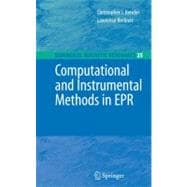
Note: Supplemental materials are not guaranteed with Rental or Used book purchases.
Purchase Benefits
What is included with this book?
| Chapter 1 Microwave Amplitude Modulation Technique to Measure Spin–Lattice (T1) and Spin–Spin (T2) Relaxation Times | |||||
|
|||||
|
1 | (2) | |||
|
3 | (4) | |||
|
7 | (5) | |||
|
12 | (3) | |||
|
15 | (1) | |||
|
16 | (3) | |||
|
19 | (1) | |||
|
20 | (11) | |||
| Chapter 2 Improvement in the Measurement of Spin–Lattice Relaxation Time in Electron Paramagnetic Resonance | |||||
|
|||||
|
31 | (1) | |||
|
32 | (7) | |||
|
39 | (14) | |||
|
53 | (25) | |||
|
78 | (5) | |||
| Chapter 3 Quantitative Measurement of Magnetic Hyperfine Parameters and the Physical Organic Chemistry of Supramolecular Systems | |||||
|
|||||
|
83 | (3) | |||
|
86 | (5) | |||
|
91 | (10) | |||
|
101 | (9) | |||
|
110 | (11) | |||
|
121 | (9) | |||
|
130 | (2) | |||
|
132 | (11) | |||
| Chapter 4 New Methods of Simulation of Mn(II) EPR Spectra: Single Crystals, Polycrystalline and Amorphous (Biological) Materials | |||||
|
|||||
|
143 | (3) | |||
|
146 | (8) | |||
|
154 | (7) | |||
|
161 | (2) | |||
|
163 | (9) | |||
|
172 | (3) | |||
|
175 | (4) | |||
| Chapter 5 Density Matrix Formalism of Angular Momentum in Multi-Quantum Magnetic Resonance | |||||
|
|||||
|
179 | (1) | |||
|
180 | (2) | |||
|
182 | (1) | |||
|
183 | (1) | |||
|
184 | (1) | |||
|
185 | (3) | |||
|
188 | (1) | |||
|
188 | (2) | |||
|
190 | (1) | |||
|
191 |
The New copy of this book will include any supplemental materials advertised. Please check the title of the book to determine if it should include any access cards, study guides, lab manuals, CDs, etc.
The Used, Rental and eBook copies of this book are not guaranteed to include any supplemental materials. Typically, only the book itself is included. This is true even if the title states it includes any access cards, study guides, lab manuals, CDs, etc.